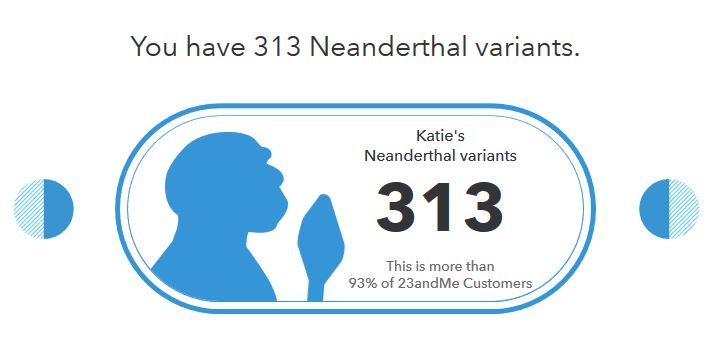See Part 1 of this series to find out what I knew about my
family background before having a DNA test done. See Part 2 of this series for the results of my first test.
As I mentioned in my previous post in this series, I eventually decided to get my DNA tested again through a different company. It was a difficult decision to make -- the cost was even higher and, to be frank, I think Husband thought I was a little mad. But I had to know.
The second analysis was done through 23andMe, a company based in the U.S. The process was exactly the same as the other test. Because the kit was sent to me and sent back via courier, it was actually much faster than through AncestryDNA. The kit arrived at their lab within 3 days, and I had my results 3 weeks later. The analysis from 23andMe has reports from 4 different areas, not just my ancestry analysis, so I was interested to see what those were, too. (U.S. customers have access to health reports too, but these are not available for Australian customers. Some kind of annoying legal thing, typical...)
Here is my summary result:
And my detailed result:
EUROPEAN:
British & Irish: 55.5% (includes U.K., Irish)
French & German: 15.2% (includes Austrian, French, German, Belgian, Dutch, Swiss)
Scandinavian: 0.8% (includes Danish, Norwegian, Swedish)
Broadly Northwestern European: 27.8%
Broadly European: 0.6%
MIDDLE EASTERN & NORTH AFRICAN:
North African: < 0.1% (includes Algerian, Bahrani, Bedouin, Egyptian, Jordanian, Kuwaiti, Moroccan, Mozabite, Palestinian, Saudi Arabian, Tunisian, Emirati, Yemeni)
SUB-SAHARAN AFRICAN:
Broadly Sub-Saharan African: < 0.1%
ASIAN & NATIVE AMERICAN:
Native American: < 0.1% (includes Colombian, Karitiana, Maya, Pima, Surui)
If you've read my previous post about my results from AncestryDNA, you'll notice a few differences!
There is no Caucasian or South Asian DNA in this set of results. There's a lot less British, and barely any Scandinavian. There is no trace of Finnish or Russian in this set. However, there is African and -- a huge surprise -- Native American. However, remembering what I learned from my previous test, I reminded myself that these results are all probabilites, not definites.
The way the analysis is done is different too. My DNA is compared to samples from 31 regions, rather than 26 with AncestryDNA. The regions are split up differently, too -- British and Irish are one entity in this set. "French and German" is broadly equivalent to Western European in the other set, but the boundaries are different. My DNA was compared with 10,000 samples, which is more than Ancestry's sample size of 3,000, and of course the sample set comes from different people, so therefore the results could be different.
When I started looking deeper into these results, I saw that the way probability was handled is different. My data is displayed in the form of a 'Chromosome Painting.' I can choose the probability certainty of the results using a slider: from 50% through to 90%. 50% is the default, and this is what was displayed when I first saw my results. It means that for every piece of DNA examined, there was a 50% chance that it matched with a specific regional group. Actually, 50% doesn't seem a very high percentage to me! When I played with the slider, things looked very different.
Here is the slider set to 80%:
Now, the percentage of British & Irish DNA has dropped to 16.1%. The broader categories have risen. All of the lower-ranked regions have been relegated to the 'Unassigned' basket. Even with the slider set to 60%, the Native American portion of my DNA was shunted over to 'Unassigned'. It took a little while for this to sink in, but eventually this fact clicked in my brain:
of that less-than-1%, there's a 40-50% chance it's from somewhere else.
And where that 'somewhere else' is, nobody knows. Perhaps I should be upset by this vague and unlikely result, but I'm not. It just confirms how difficult it is to pin down our DNA heritage.

This series of posts isn't meant to be a review or comparison of the two different tests. Both have different criteria, and different ways of displaying the results, neither of which is better than the other, I think. This website has a very comprehensive page on all the companies that offer genetic testing (currently 5). All offer slightly different services, so it's up to the individual to decide which one to choose. Apparently some hardcore genealogy fans have had tests done through all five!
Having a DNA analysis done is an experience that's hard to describe. It's a very emotional experience. Perhaps the emotions are different depending on whether you get along with your family or not, but they're there nevertheless. There's a chance that your DNA heritage could be different from your cultural heritage, and this could impact on your relationship with your family. There's also a financial component -- the test costs between $180 and $250, depending on the company. It's a big investment, and you want it to be worth it.
If you're thinking of having a DNA analysis done, here are a couple of things to keep in mind:
* Decide what kind of results you are looking for first: genetic testing, genealogy research, getting in touch with relatives, etc. and choose your service based on this.
* Don't expect precise results. DNA technology can't (and probably won't ever) be able to give you answers beyond a certain probability.
* Let go of any expectations. You may not be what you thought you were. Treat the analysis as a fact-finding mission, not a confirmation of what you think you know.
I, according to the results, am more Neanderthal than most people:






No comments:
Post a Comment